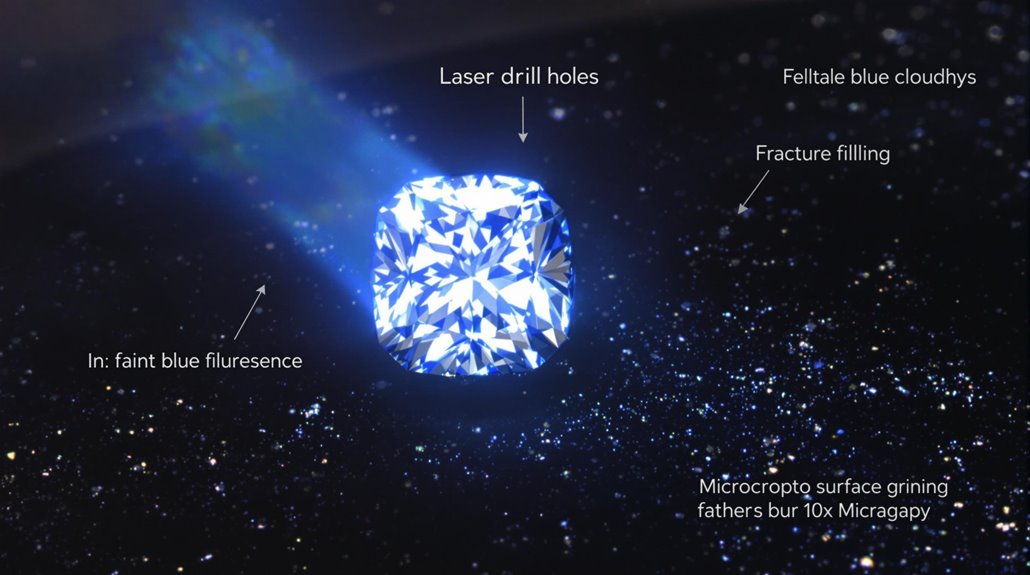Article Contents
- 1 Frequently Asked Questions
- 1.1 How Much Do Diamond Treatments Affect the Long-Term Value of a Stone?
- 1.2 Are Treated Diamonds Covered by Insurance Policies the Same as Natural Ones?
- 1.3 Can Diamond Treatments Fade or Deteriorate Over Time?
- 1.4 Which Diamond Treatments Are Considered More Ethical in the Industry?
- 1.5 Do Treated Diamonds Require Special Care When Wearing or Cleaning Them?
Diamond treatments can be identified through a combination of visual inspection and advanced analytical methods. Expert jewelers utilize specialized equipment like loupes and microscopes to detect telltale signs, including drill holes, flash effects, and fracture fillings. Spectroscopic analysis, particularly FTIR and Raman spectroscopy, reveals subtle modifications in chemical composition and crystal structure. UV light examination and photoluminescent spectroscopy further expose synthetic origins and improvements, though mastering these detection techniques requires extensive expertise.
The art of identifying diamond treatments requires a sophisticated mixture of scientific insight and expert observation techniques. Within the sphere of precious stones, grasping the methods used to improve diamonds enables connoisseurs and collectors to make informed decisions about their investments.
Visual inspection, performed with specialized equipment such as loupes and microscopes, serves as the first line of detection for treated stones. Through careful examination under magnification, experts can identify telltale signs of enhancement, including drill holes, fracture fillings, and characteristic patterns that suggest high-pressure, high-temperature treatments. Diamond testers provide immediate verification by measuring thermal conductivity of suspected treated stones.
Spectroscopic analysis has transformed the way diamond treatments are identified, offering precise scientific methods that complement traditional visual inspection. Advanced techniques such as Fourier Transform Infrared Spectroscopy (FTIR) and Raman spectroscopy allow gemologists to analyze the chemical composition and crystal structure of diamonds, revealing subtle modifications that might otherwise go undetected. The process requires extensive data documentation to maintain accuracy and track findings over time.
These sophisticated tools can distinguish between natural and synthetic diamonds while identifying specific treatments that alter color or clarity. The presence of certain treatments becomes apparent through specialized testing methods, particularly when examining stones under ultraviolet light or using X-ray fluorescence. The accurate assessment of a diamond's quality and authenticity is crucial for maintaining consumer confidence in the market.
These techniques reveal fluorescence patterns and elemental compositions that can indicate synthetic origins or specific enhancement procedures. Photoluminescent spectroscopy, performed at liquid nitrogen temperatures, has become particularly valuable in detecting HPHT treatments through the analysis of characteristic spectral patterns.
Common treatments such as laser drilling and fracture filling leave distinctive markers that trained observers can identify. Laser-drilled channels, often filled with glass-like substances, create minute pathways visible under proper illumination. Resin-like materials are commonly used in fracture filling treatments to enhance clarity and improve the overall appearance of the stone.
Fracture fillings manifest as flash effects or subtle color changes when viewed from different angles, while high-temperature annealing and irradiation treatments produce specific color modifications that can be detected through careful analysis.
The evolution of diamond enhancement techniques has led to increasingly sophisticated methods of detection, requiring gemologists to maintain current knowledge of both treatments and identification procedures.
The combination of visual examination and advanced spectroscopic analysis provides an all-encompassing approach to authentication, safeguarding the integrity of diamond certification and valuation. For those invested in the sphere of fine jewelry, grasping these detection methods has become crucial, as it safeguards investments and maintains the prestigious status of natural, untreated diamonds in the marketplace.
Frequently Asked Questions
How Much Do Diamond Treatments Affect the Long-Term Value of a Stone?
Diamond treatments significantly reduce long-term value, with market perception favoring natural stones. Treated diamonds typically maintain lower resale value owing to limited desirability and concerns about treatment stability.
Are Treated Diamonds Covered by Insurance Policies the Same as Natural Ones?
Although 85% of insurance policies cover treated diamonds similarly to natural ones, specific exclusions may apply for unstable treatments. Coverage terms depend on treatment disclosure and regular inspections for value comparison.
Can Diamond Treatments Fade or Deteriorate Over Time?
Some diamond treatments can fade or deteriorate whereas others remain stable. Coatings and fracture fillings have limited treatment longevity, but HPHT, irradiation, and annealing are permanent, non-fading treatments.
Which Diamond Treatments Are Considered More Ethical in the Industry?
Treatments fully disclosed and certified by recognized laboratories align with ethical sourcing principles and industry standards. Surface coatings and HPHT processes receive broader acceptance when transparency requirements are met.
Do Treated Diamonds Require Special Care When Wearing or Cleaning Them?
Over 80% of treated diamonds require specific care protocols. Cleaning methods vary by treatment type, with fracture-filled stones needing gentle solutions. Wearing precautions include avoiding harsh chemicals and extreme temperatures.

